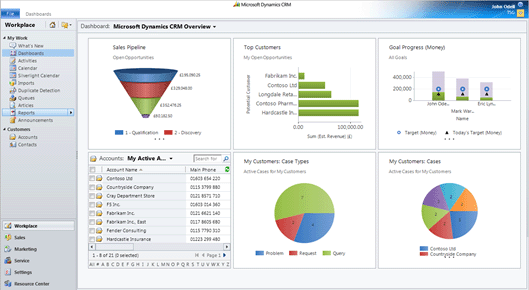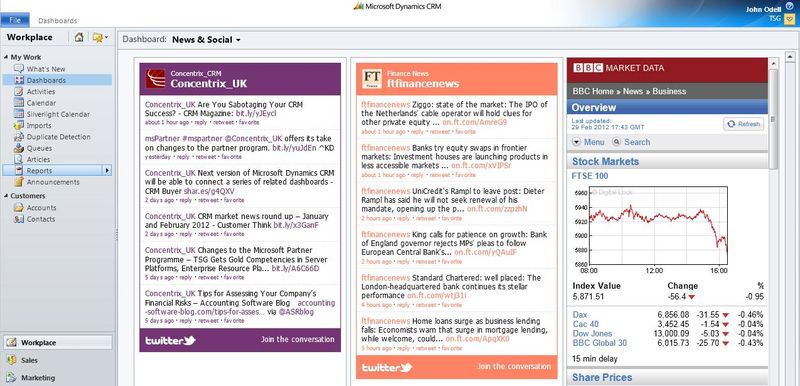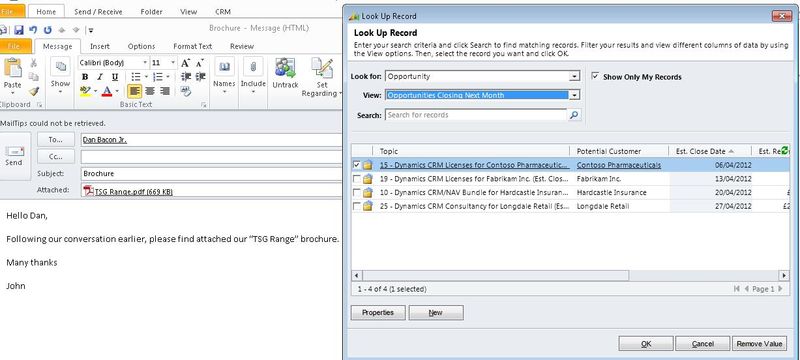Here’s a guest post by Senior CRM Consultant, Microsoft Dynamics CRM specialist and something of an evangelist for the product, John Odell. Over the years, John has been involved with many major and highly successful projects based around Microsoft Dynamics CRM, and his opinions are valued by technical and non-technical users alike.
Here’s John’s post:
Upgrading to Microsoft Dynamics CRM 2011, by John Odell
It’s been well over a year since the release, in the UK, of Microsoft Dynamics CRM 2011 and Microsoft Dynamics CRM Online, the cloud version of the product.
Upgrading CRM systems can seem daunting. Many organisations wait until they really have to upgrade before doing so, and not always without reason. There are lots of things to consider in terms of your upgrade strategy. These include testing, training, minimising downtime, resources, cost versus benefit analysis, deciding whether or not you should move to ‘the cloud’, not to mention how to make the most of the new things that the latest version of the software offers you.
In the past, upgrading hasn’t always been as easy as it should be. For example, Microsoft Dynamics CRM version 4 was released in 2007. It made a big impact on the uptake and use of CRM software in the UK, from small business deployments to enterprise solutions. However, upgrading from Microsoft Dynamics CRM version 3 to versions 4 was, in a nutshell, a horrible job.
I don’t make a habit of giving Microsoft undue credit, but they really deserve a big pat on the back for the tools they have provided us to upgrade from Microsoft Dynamics CRM version 4 to Microsoft Dynamics CRM 2011 (which they really should have called version 5, which goes to show Microsoft don’t always get it right!).
Why should you upgrade to Microsoft Dynamics CRM 2011?
There are a whole variety of reasons to upgrade to Microsoft Dynamics CRM 2011. Many of these depend on the individual needs of your organisation. However, there are also some strong reasons which apply to nearly all businesses. Here are a few quick highlights:
Dashboards Microsoft Dynamics CRM 2011
Dashboards are a great way of putting essential information in front of users, helping them to do their job and make better decisions. Dashboards are easy to create, and can contain “live” CRM content, which can be in list view and a wide array of visual charts and graphs. Dashboards can be role tailored, containing and displaying data relevant to each user or each user’s job, and they can also include external content and specific information, as shown in the example screenshots.

Example Screenshot of a Microsoft Dynamics CRM 2011 Dashboard

Example Screenshot of Microsoft Dynamics CRM 2011 Dashboard with external content – Twitter feeds and BBC content
Personalisation and Ease of Use
In terms of appearance, one of the biggest differences between Microsoft Dynamics CRM version 4 and Microsoft Dynamics CRM 2011 is that the later version has an Office 2010-style ribbon with contextual menus. Everything is just one or two clicks away for the user! I’ve noticed people quickly go to love this feature.
One of my favourite things in Microsoft Dynamics CRM 2011 is that you can personalise views and set your own default views. Microsoft has also improved the “set regarding” feature when tracking emails from Outlook, with “show only my records” and use saved Views (another personal favourite). This is a relatively small change but makes it so much easier to properly track emails and appointments.
Personalisation of list views through Outlook is also great. Conditional formatting allows you to highlight records that meet specific criteria. You could make all opportunities closing this month appear in bright pink Comic Sans, for example (I’m not suggesting you should!). You can also “pin” multiple views to the screen and choose what fields (columns) to see. Role tailored forms, dashboards, navigation and field level security also greatly enhance personalisation and are all popular features which benefit many users of the product.

Example Screenshot of Microsoft Dynamics CRM 2011 “Set Regarding” improvements – a personal favourite
Management and Productivity Information
There’s some excellent functionality here which can deliver some major benefits. But it’s also a whole separate blog post for another day…
Microsoft Dynamics CRM Marketplace
The CRM Marketplace is a bit like an app store, but with a totally different name! You can find, try and buy all sorts of exciting plug-in products to enhance your CRM solution. The Marketplace is certainly worth a browse whether you’ve upgraded or not.
Development and Integration Capabilities (techie stuff)
Microsoft Dynamics CRM 2011 has enhanced capabilities for configuration, and here are some of the top things our technical people like:
More, Newer, Cooler Stuff is Coming…
…all the time! In the past year Microsoft has released quite a few mini-upgrades and will continue to do this on a frequent basis (rather than waiting four years between releases). For example, by summer 2012 Microsoft is due to release:
-
Browser support for “front end” pages (not admin) on Firefox, Safari, and Google Chrome (as well as Internet Explorer, of course) across PC, MAC and iOS… (I am a bit sceptical about this one, to be honest)
Support for Microsoft Dynamics CRM version 4 Ends in a Year’s Time!
In the UK, mainline support for Microsoft Dynamics CRM version 4 comes to an end 9th April 2013. This means Microsoft will stop issuing updates for v4, except for major security updates (which will be supported to April 2018).
Our recommendation is not to operate a CRM system outside of mainline support unless if can’t be helped. So, even if you’re not looking to upgrade any time soon you should certainly start thinking about it…
You can see more screenshots of Microsoft Dynamics CRM 2011 of the Concentrix TSG website. If you want to find out more about why and how to upgrade to Microsoft Dynamics CRM 2011, or to talk about how to approach an upgrade, please don’t hesitate to contact me or any of the team at Concentrix TSG!
John Odell, CRM Specialist
You can find me on Twitter: @odellodell
And of course Concentrix TSG: @Concentrix_UK